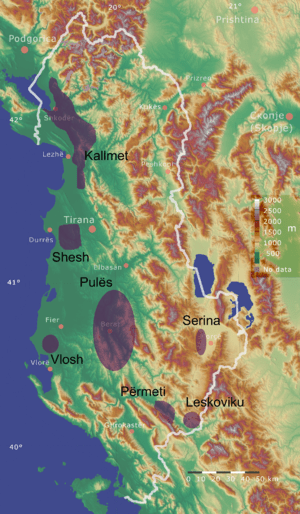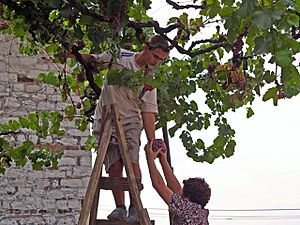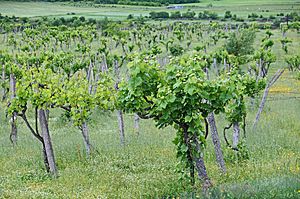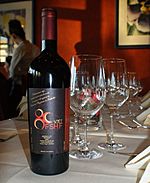Albanian wine facts for kids
Albanian wine (which is called Vera Shqiptare in Albanian) is made in different parts of Albania. This country is located near the Mediterranean Sea. Albania has a very old tradition of making wine, going back at least 3,000 years! This means it started way back in the Bronze Age with the ancient people called the Illyrians. Albania is known as one of the "old world" countries when it comes to making wine.
Albania is a mountainous country with the Mediterranean Sea to its west. It has a special Mediterranean climate, which means winters are mild and summers are usually hot and dry. This good climate and the rich soil in the mountains are perfect for growing grapes.
In 2009, Albania produced about 17,500 tonnes of wine.
Contents
History of Albanian Wine
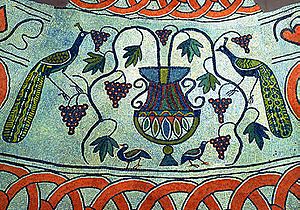
The land that is now Albania was one of the few places where grapevines survived during the last Ice Age. Some of the oldest grape seeds found in this area are between 4,000 and 6,000 years old!
Along with nearby Greece, Albania has one of the longest continuous histories of growing grapes for wine in Europe. This tradition existed in Illyria hundreds of years before the Roman Empire grew in the Balkan Peninsula.
During the time of the Roman Empire, making wine became more common and organized. You can see pictures of wine-making on many old religious and household items, like those found in Butrint. However, in the 1400s, the Ottoman Turks arrived in Southeastern Europe. During their rule, grape growing for wine decreased. Vineyards were mostly found in areas where many Christians lived.
After Albania became independent, growing grapes for wine became popular again. But in 1933, tiny insects called phylloxera almost destroyed all the grapevines. A big improvement in wine production only started after World War II. At that time, only about 2,737 hectares (about 6,763 acres) of land were used for growing grapes. The most important area for wine was around Durrës, where large state-run farms grew grapes.
In those days, the amount of land used for grapes was similar to that for tobacco, but much less than for olive or fruit trees. The wine that Albania exported mostly went to Germany. However, wine exports slowly went down from 1971 to 1985. This was mainly because the ways of making wine were old-fashioned, and the equipment wasn't good enough for transport, which lowered the quality. On the other hand, exporting dried grapes (raisins) kept increasing. Some of the common grape types grown then were Merlot, Cabernet Sauvignon, Pinot Noir, Sangiovese, and Riesling.
Since Albania became a democracy and started using capitalism, vineyards and wine production have been growing steadily.
How Wine is Made
| 1950 | 1960 | 1970 | 1980 | 1990 | 2007 | 2009 | 2015 | |
|---|---|---|---|---|---|---|---|---|
| Vineyard area (ha) | 2,430 | 8,545 | 11,020 | 16,719 | 17,621 | 9,103 | 9,806 | 10,178 |
| Production (tonnes) | 21,400 | 22,300 | 64,500 | 66,200 | 91,000 | 146,500 | 162,800 | 204,000 |
The table above shows how much land was used for vineyards and how much wine was produced over the years. You can see that both the area of vineyards and the amount of wine produced have generally increased a lot since 1950, showing how much the industry has grown.
Where Grapes Grow in Albania
Albania has four main areas where grapes are grown for wine. These areas are mostly defined by how high up they are (their altitude). They include:
- The coastal plains (Western lowlands): These areas are up to 300 meters (about 990 feet) high. They include towns like Tiranë, Kavajë, Durrës, Shkodër, Lezhë, Lushnje, Fier, Vlorë, Pukë, and Delvinë.
- The central hilly region: This area is between 300 and 600 meters (about 990 to 1,980 feet) high. It includes places like Elbasan, Krujë, Gramsh, Berat, Përmet, Librazhd, and Mirditë.
- The Eastern sub-mountainous region: This region is between 600 and 800 meters high. It surrounds towns like Pogradec, Korçë, Leskovik, and Peshkopi.
- Mountains (Highlands): Grapes are even grown as high as 1,000 meters (about 3,300 feet) in these areas. The soil here is usually clay and silica, which means it's a mix of clay and sand, and it varies in how deep it is and how much sun it gets.
The highest vineyards are found at about 1,000 to 1,300 meters (about 3,300 to 4,265 feet) on the slopes of the Albanian Alps in the north and the Pindus Mountains in the southeast.
Special Albanian Grapes
Albania has many unique grape types that are native to the country. These are called "indigenous" varieties. Some of the main ones include:
- Shesh (which comes in black and white types)
- Kallmet
- Vlosh
- Serinë
- Pulës
- Cërujë
- Mereshnik
- Debin (also black and white types)
- Kryqës
- Mjaltëz
- Mavrud
- Manakuq
- Kotekë
- Vranac
- Stambolleshë
- Babasan
- Tajgë (red and white types)
Wineries in Albania
Wineries are places where wine is made, and they are called kantina in Albanian. Here are some of the wineries you can find in Albania:
- Medaur
- Kallmeti
- Rilindja
- Skënderbeu
- Çobo
- Luani
- Bardha
- Arbëri
- Sara
- Alimani
- Vintage
- Constantino Spanchis
- Kardinal
- Zika
- Belba
- Nurellari
- Balaj
- Koto
- Vila Duka
- Vila Shehi
- Vila Hadaj
- Belba
- Enol
- Korca 2000
- Kokomani
Favorite Albanian Wines
Experts Nasse and Zigori (from 1968) said that the best native Albanian grape varieties for wine are Debinë (both black and white), Kallmet, Mereshnik, Mjaltëz, Serinë (red and white), Shesh i Bardhë, and Vlosh. They also thought that the best areas for making wine are Berat, Korçë, Tiranë, Durrës, and the region between Lezhë and Shkodër.
See Also
- Albanian cuisine
- Albanian alcoholic drinks


